The introduction of alien species may pose an enormous threat to indigenous flora and fauna. Among introduced animals, probably the most destructive to the natural environment are mammals. This is true at least in regard to the Afrotropical Region (sub-Saharan Africa). This review attempts to summarize our knowledge on alien mammals in this region and their impact on indigenous vertebrate fauna. This review includes 56 mammal species, belonging to 20 families, introduced to sub-Saharan Africa over the last 2000 years. Most are representatives of the following orders: Artiodactyla, Carnivora, and Primates. Most species introduced to sub-Saharan Africa originated from the Oriental (n = 20) and Palearctic (n = 19) regions. Two species,
Mus musculus and
Rattus rattus, were introduced before 1400 (probably as early as 800 AD), while three others were introduced between 1401 and 1700. The first half of the 17th century saw the highest number (n = 10) of introduced species. Between 1651 and 1850, only two species were introduced; in the following 175 years (1851–2025), as many as 24 species were introduced. Ten of the introduced mammal species, namely
Sus scrofa,
Capra hircus,
Rattus rattus,
R. norvegicus,
Mus musculus,
Felis catus,
Canis familiaris,
Viverricula indica,
Urva auropunctata, and
Maccaca fuscicularis, have become invasive species. A total of 39 mammal species were relocated (mainly for hunting purposes) within sub-Saharan Africa. Most of them were representatives of the family Bovidae (76.9%). Relocations are not considered introductions. Based on published records of the impacts of alien mammals on the vertebrate fauna of sub-Saharan Africa, the following mechanisms may be distinguished: predation, competition, hybridization, transmission of diseases and parasites, and habitat destruction (grazing, herbivory, browsing). Most vertebrate species (79.4%) were affected through direct predation, predation and habitat destruction (7.1%), or predation and competition (1.4%). Alien mammals have caused habitat destruction for only 10 species (7.1%). Other effects (competition and genetic pollution) were marginal (3.5%). At least 144 vertebrate species, representing 52 families, have been affected by alien mammals in sub-Saharan Africa: 3 amphibians, 23 reptiles, 89 birds, and 29 mammals. As a result of mammal introductions, 65 species in sub-Saharan Africa have become globally extinct, 45 are considered threatened (listed in the RDB), and 31 other species are in decline, although not included in the RDB. Most extinct birds were affected by introduced rats, mice, feral cats, and dogs. In continental Africa, only seven vertebrate species have been negatively affected by alien mammals. All other affected vertebrates occur on islands. An especially high rate of extinction has been recorded in the Mascarene Islands. In comparison with alien birds in sub-Saharan Africa, the number of introduced mammal species is much lower, but their negative impact on vertebrate fauna is significantly greater.
Full article





